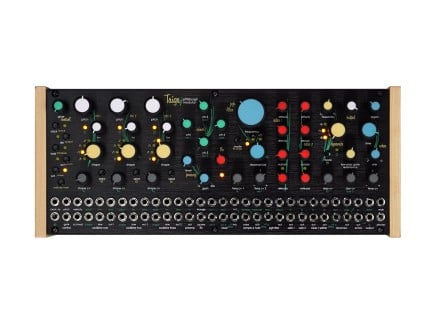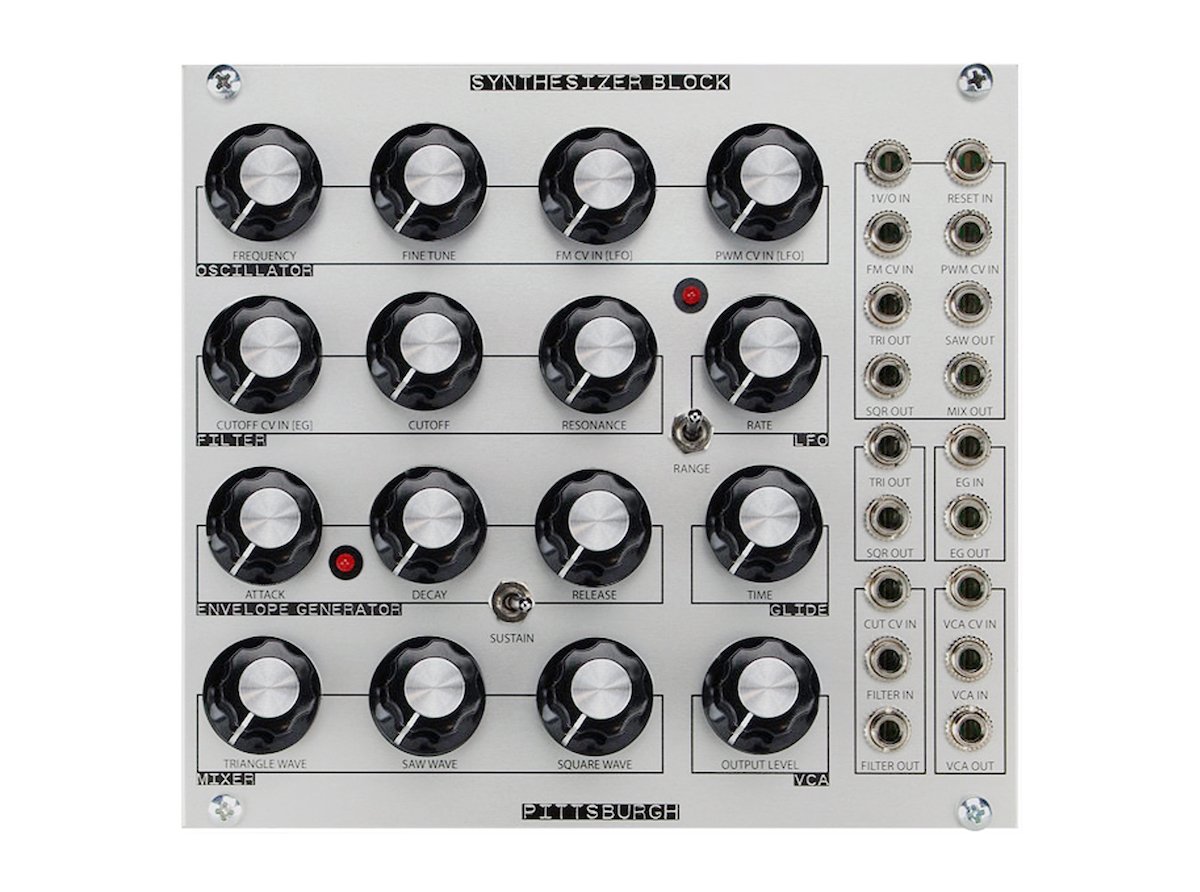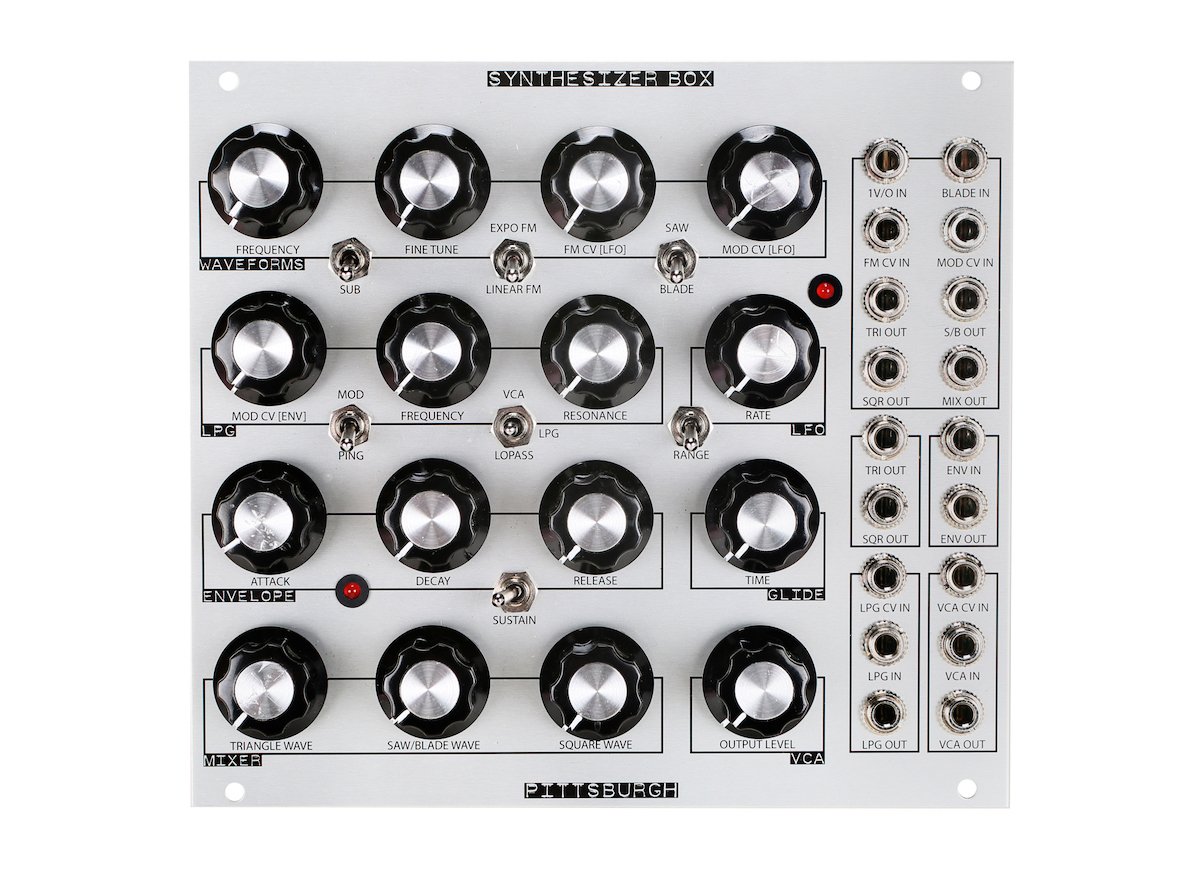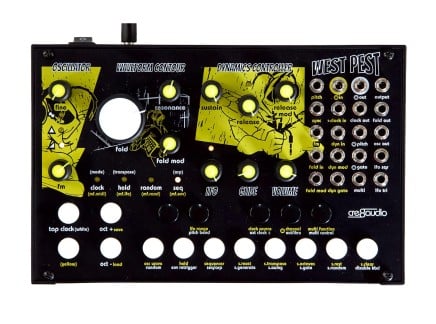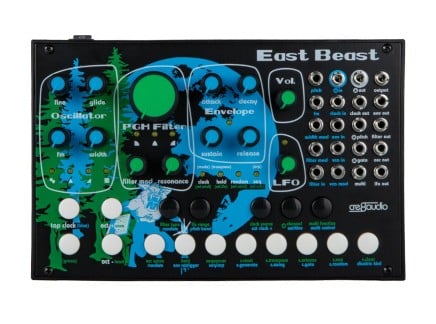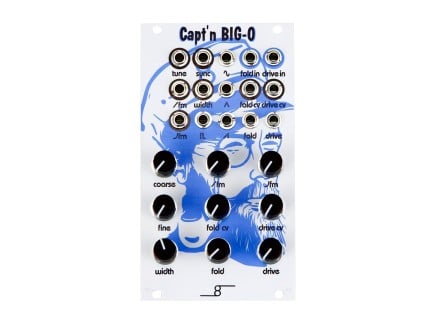Pittsburgh Modular has introduced Taiga, their newest self-contained semi-modular instrument. Those who have been waiting for the "next thing" after the discontinuation of the SV-1 Blackbox and Voltage Research Laboratory can rejoice: Taiga takes the ideas in each of these instruments and pushes them to the next level. In fact, I think it's fair to say that Taiga well may be Pittsburgh's most complete, sophisticated, and best-thought-out instrument to date.
Taiga is a semi-modular synthesizer with a 60-point patch bay. It makes extensive use of internal normalled connections, such that the basic signal flow is the sort of thing you'd expect from a typical monosynth: three oscillators into a mixer, into a filter, into an articulative structure, with two ADSR envelopes and a dedicated LFO. It even adds an analog delay at the final output stage for some extra space. But to break down Taiga that simply would be a great disservice, as it has a number of tricks up its sleeve. Each submodule is fully modular, with all important parameters accessible via voltage control, and complete ability to interrupt all normalled connections. It also features Pittsburgh's newest iteration of their Dynamics controller—their unique take on the Lowpass Gate. It also features MIDI to CV, an internal arpeggiator and sequencing functionality, paraphonic operation, and more wavefolders than I've ever seen on a single synth voice. Additionally, it can be removed from its included housing and placed in a Eurorack case, occupying 60hp and roughly 40mm of depth. So, although it might at first look like a typical monosynth...there's much more to it than that.
Taiga borrows equally from what many now know as the "East Coast" and "West Coast" synthesis paradigms. Broadly speaking, these design ideologies are based on early analog synthesizer designs by Bob Moog and Don Buchla, respectively. While this particular article isn't the place to go deep into the difference between East Coast and West Coast synthesizer design (instead, see this article for the nerdy details), it's certainly worth mention—its focus on some of the sonic strong points of each of these "styles" of synthesis is what gives Taiga its unique voice. Ultimately, it feels like Taiga is taking the concepts from these classic analog approaches and pushing them as far as they will go, discovering completely new territory along the way.
Of course, Taiga isn't the first such instrument that Pittsburgh has created: their focus on furthering the possibilities presented by certain tools from each of these schools of thought has resulted in several remarkable designs. As such, let's take a brief look back at some of Pittsburgh's previous instruments—which should help us understand what Taiga is all about. Afterward, we'll dive deeper into Taiga's inner workings...revealing its unique possibilities for patching, sound design, and performance. If you want to skip the history lesson and go straight to our overview/review of Taiga, you can jump straight there using this link. For those looking to see how Taiga came to be? Read onward.
Pittsburgh's History of Coastal Exploration, Experimentation, and Semi-Modular Synthesizers
Those familiar with Pittsburgh's history will realize that they've always explored East Coast and West Coast-esque design ideologies since their inception. It's my perception, though, that many look back on the earliest generation of Pittsburgh Eurorack modules as being largely focused on bread-and-butter "East Coast"-esque analog designs. That's not such a surprise—their earliest generation of Eurorack modules included a spectacular analog oscillator and the first iteration of the Pittsburgh filter. At the time (and still to this day), that filter especially drew a lot of attention, and for good reason: it sounds great. They also made a host of other fairly straightforward modules—ADSRs, LFOs, etc. But they also made some quite bizarre, experimental devices. The Generator + Expander, for instance, was a complex dual oscillator that intentionally did not track terribly well, designed specifically for producing extreme/chaotic sounds. Their sales literature described it as being ideal for "atonal, nintendo zipper/fart noises," among other things. It was a pretty apt description. This initial lineup also included experimental modulation sources like the Bender, which contained two cross-modulated LFOs for creating chaotic, ever-evolving modulation signals, and the VILFO, a peculiar "voltage-influenced" LFO.
In some ways, their initial product lineup, to me, seemed divided between more practical, pragmatic modules and some truly out there, bizarre designs. While you could, of course, combine these modules together, there seemed to me to (perhaps) be a conceptual divide between what they were trying to do with each side of their product line. Things soon came into clearer focus as new designs emerged, however.
Pittsburgh Modular has always developed Eurorack synthesizer modules throughout their history, but for the sake of this discussion, I'd like to turn our focus primarily toward their self-sufficient, all-in-one semi-modular instruments. Some of their first "self-contained" instruments included small modular systems that combined their MIDI to CV module with all-in-one voice modules: specifically, the Synthesizer Box and Synthesizer Block. The Synthesizer Block was a straightforward, classic "East Coast" voice all in a single module: it combined an oscillator, an oscillator waveform mixer, a lowpass filter, an LFO, a simple ADSR envelope, and a VCA into a single, semi-modular Eurorack module. All critical patch points were available, though it featured a normalled signal connection scheme to create a typical "synth voice" with no patch cables required. Just connect to the included MIDI to CV module or an external CV source, and boom, you're ready to play.
The Synthesizer Box at first glance might seem identical to the Synthesizer Block: but it took a slightly more esoteric, West Coast-inspired approach. The Synthesizer Box included a complex oscillator focused on linear and exponential FM and voltage-controlled waveform morphing, complete with the atypical "blade" waveshape. It also included a resonant lowpass gate in place of the typical filter, great for creating classic plucks and pinged tones. Aside from that, it was basically identical to the Synthesizer Box; the oscillator and filter were the definitive features of each design. As Pittsburgh progressed, they created several standalone modules that went deeper into both classic synth sounds and experimental tone shaping alike—producing many generations of esoteric oscillators, lowpass gates, etc. But after the Synthesizer Box and Synthesizer Block, they also placed a stronger focus on self-contained synthesizers as well.
Perhaps the most popular Pittsburgh instrument to date was one such exploration: the Lifeforms SV-1 Blackbox. The SV-1 took the basic concepts of many of Pittsburgh's popular modules and their all-in-one voice modules (the Box and the Block) and combined them into a single, more refined, and much more flexible design. The SV-1 module featured an integrated MIDI to CV converter, two oscillators, a stellar-sounding state-variable filter, a clean VCA, a wide-range LFO, noise source, sample and hold, mixer, ADSR envelope, signal splitters, and both line level and headphone outputs. The first oscillator offered two suboscillator outputs, the iconic "blade" wave, and options for hard sync and FM. The filter provided lowpass, highpass, and bandpass outputs. And best of all, the patch bay broke out all significant inputs and outputs—so despite the fact that it was optimized to work as a monosynth without any patching necessary, it was still possible to treat it like a fully modular synthesizer.
The SV-1 was available both as a Eurorack module and in a dedicated enclosure (the "Blackbox" model), as well as in several modular configurations (many of which included the Lifeforms KB-1 pressure-sensitive touchplate keyboard controller/sequencer). Most importantly, it sounded excellent. It incorporated many of the unique takes on synthesis that Pittsburgh had cultivated in prior designs, but presented them in an accessible, affordable, and a just downright cleverly-organized package. It was a huge success. Admittedly, though, it leaned more toward the "classic analog synth" paradigm than some of their modular offerings...but their next self-contained instrument would change that.
The Microvolt 3900 was, according to Pittsburgh, a "love letter to the analog monosynth." While it certainly was organized to act like an analog monosynth, it took several steps into the more peculiar sonic territory they had been developing in their modular line. Microvolt 3900 included a voltage-controllable wavefolder, the classic Pittsburgh-style resonant lowpass filter, a new Dynamic VCA design (one of their first excursions into exploring proprietary lowpass gate-esque designs), output overdrive, chaotic CV generation, a multi-purpose function generator (for envelope, LFO, and oscillator duties), integrated MIDI to CV with sequencing/arpeggiation capability, and more. The Microvolt's 39-point patch bay made it, once again, quite capable of acting as a fully modular system despite its default normalled signal connections. The Microvolt 3900 was, to date, Pittsburgh's most unique self-contained instrument...and it laid the groundwork for their next instrument.
At the time of its release, the Voltage Research Laboratory (VRL) was Pittsburgh's most ambitious instrument: an "organic modular synthesizer" that dove deeply into experimental synthesis techniques with the aim of modeling the behaviors of real-world, organic systems. All but eschewing the traditions of East Coast synthesis, the VRL was Pittsburgh's most experimental instrument altogether—seemingly taking significant inspiration from the Buchla Music Easel.
The Voltage Research Lab included a MIDI to CV converter with arpeggiation, a primary oscillator and secondary oscillator, two looping function generators, two Dynamics Controllers, and an analog delay, alongside an extensive patch bay (which also included a sample and hold, a separate stepped random CV generator, function logic, and additional mixing options). It also featured a dedicated touch controller/sequencer module (the Lifeforms Touch Controller), which offered location-sensitive touch pads and sequencing capabilities. The two modules were paired together in the quite classy-looking Voltage Research Console case. It's also worth noting that the Voltage Research Laboratory voice module wasn't semi-modular, per se. Instead of relying on normalled internal signal connections between modules, it was necessary for the user to patch everything: so despite having all the components behind one panel, it was still up to the player to experiment and find signal paths that worked well for the task at hand, leading to many a happy accident and an overall experimental approach to sound design and performance.
The Voltage Research Lab also notably featured the first appearance of one of Pittsburgh's crowning achievements: a wavefolding tolopogy that could fold any waveshape. Typically limited to use with waveforms with continuously sloped contours (like sines or triangles), traditional wavefolders have notoriously subtle/unsatisfactory effects on square waves (and saw waves, to a lesser extent). In VRL, though, Pittsburgh revealed some magic twist that made it such that these shapes could be folded...resulting in synthesizer tones that so far had never been heard. This paired with their newest iteration of the Dynamics Controller (their unique lowpass gate topology) made the VRL not only a triumph in experimental synthesis design: it was a potent packaging of sounds and techniques that were definitively "Pittsburgh" in origin, inspired by the weird inner workings of classic "West Coast" instruments. You can think of VRL like the West Coast counterpart to the SV-1 (and its own accompanying touch controller).
The Voltage Research Lab, however, was a limited release: only a small number were made before they were discontinued (which, in the broad world of experimental synthesizer enthusiasts, was regarded as a disappointing outcome). Surrounding and following the release of VRL, Pittsburgh discontinued many of their long-running production modules, and began selling a number of experimental, limited-run devices—the "Safari series," each acting as an experiment in some aspect of synthesis, panel design, and production in general. This saw the release of some truly remarkable designs, such as Bat, the most fully-featured iteration of their Dynamics Controller concept to date, and Flamingo, a waveshaper based on the concepts of "center clipping" and "harmonic interpolation."
In 2022, new Pittsburgh instruments were announced...but they weren't sold by Pittsburgh themselves. Cre8audio introduced the East Beast and the West Pest: a pair of self-contained, semi-modular analog synthesizers that provided a specific sonic focus on East Coast synthesis and West Coast synthesis, respectively. Designed by Pittsburgh and produced by Cre8audio, these instruments provided all of the circuits Pittsburgh had been working to refine for years, and presented them at a price point unprecedented in any of their prior releases. The East Beast contains a classic Pittsburgh oscillator and the newest iteration of the now-iconic Pittsburgh filter, while the West Pest features Pittsburgh's unique take on the wavefolder and yet another incarnation of their Dynamics Controller.
Each of these instruments is clearly positioned as an entry-point for newcomers to hardware modular synths. They include MIDI input and arpeggiation/sequencing functionality, they can be removed from their case to act as the basis for a Eurorack system, and most importantly, they're surprisingly affordable—and as such, they've become a go-to recommendation for anyone looking to get a taste of how modular synths can work, be they eager adults or younger players on a budget. Interestingly, though, we can now see that East Beast and West Pest served another purpose: they laid the groundwork for creating Pittsburgh's newest instrument (and the primary subject of this article): Taiga.
Taiga Semi-Modular Synthesizer Overview
Taiga is the newest iteration of Pittsburgh's long-standing practice of building self-contained, semi-modular musical instruments. Like most prior designs (with the exception of Microvolt 3900), Taiga is a Eurorack-format device, so despite the fact that it does ship in its own enclosure, you may remove it in order to add it to your Eurorack system. Like most prior designs, it features an extensive internal normalled signal path. As such, it can be used right out of the box with no patching required—you can simply plug in a MIDI controller and get straight to playing. However, once you start exploring the 60-point patch bay, you'll realize that Taiga offers unprecedented sonic opportunity: everything from classic basses, leads, and West-Coast percussive tones all the way to staggeringly huge drones, heavily modulated textures, and sounds that you've truly just never heard. All internal modules are fully modular, meaning that their normalled connections can be fully over-ridden by using the patch bay; most parameters you would want to modulate can be modulated, and there are no default connections which cannot be altered by the user in the context of any given patch.
That preamble aside, let's take a look at what Taiga contains, and how you might use it.
Sound in Taiga starts with the three identical oscillators. Using the waveform selection buttons, you can select between a number of pre-set waveshapes for each oscillator individually: sine, triangle, saw, square (and "warped" versions of each, with a combined sine/pulse shape as well). Each oscillator has a dedicated 1V/octave pitch CV input, an FM input with attenuator (normalled from the LFO), a hard sync input, a dedicated sine wave output, and an output for the per-oscillator selectable waveshape. But perhaps the most interesting parameter on the oscillators has to do with those three big yellow knobs: the shape parameter. Shape controls a per-oscillator wavefolder, derived from Pittsburgh's previous "fold-any-waveshape" designs. You get the raw selected waveshape when Shape is at its minimum...but as you increase Shape, you introduce more and more wavefolding, up to an astonishingly gnarly-sounding six folding stages at the maximum. And of course, the Shape parameter is also available as a modulation destination (with a normalled connection from the LFO); it sounds particularly insane and aggressive when audio-rate modulation is applied. Experimenting with different waveshapes, folding depths, and wavefolding modulation yields a huge range of sound. (Note: when set to the pulse seed shape, the Shape parameter performs pulse width modulation rather than folding.)
It's also worth noting here that the oscillators can be made to tracking incoming MIDI data or not (by using shift+"seed"); when "listening" for MIDI, the pitch control knobs offer a narrower range in order to make it easier to dial in stacked intervals. When not tracking MIDI data, the oscillators offer a very wide frequency range, from quite slow LFOs to very high audio rates. I was initially disappointed that Taiga didn't include CV input for the LFO, but upon realizing just how slow the oscillators could go, this became more or less a non-issue. I'll also note that having a six-stage wavefolder on an LFO is, simply put, wild. And, for that matter, having a six-stage wavefolder on each of the three oscillators is also just crazy. I've never seen this on any instrument before, and while it can definitely result in quite busy, chaotic sounds, it can also lead to a startling range of timbral nuance. And of course, sometimes busy and chaotic is just what you need.
Taiga's mixer section offers five inputs: four which are normalled to the oscillators and noise source, and one which is hardwired to the preamp, which offers up to 30x gain for boosting external signals (it also makes a great distortion for modular-level tones). The mixer offers dedicated outputs for total sum and for the sum of inputs 1 and 2.
Of course, one of the other shining aspects of Taiga is the PGH filter—the newest version of Pittsburgh's stellar filter design. It offers highpass, lowpass, bandpass, and notch responses, as well as lowpass+bandpass and highpass+bandpass options. It's an all-analog two-pole, 12dB/octave design with a very clean, smooth response. The cutoff sweep has no dead spots; it eschews self-oscillation in favor of smooth, whistling resonances; and it just sounds dang good. It offers two CV inputs (one with an attenuator and one with an attenuverter), with normalled connections from the LFO and ADSR1, respectively. Given how much sonic character can be created from the oscillators themselves, I find that the notch mode in particular can be a lot of fun—using the filter for more subtle sonic variations while letting the oscillators do a lot of the sound-sculpting work. Of course, it sounds great in all modes, and with such a range of sounds available to send into it, you'll find plenty of room to explore.
After the PGH filter, the signal hits the Dynamics section: yet another iteration of their unique take on the lowpass gate concept. Quite similar in implementation to the aforementioned Safari series Bat module, the Taiga's Dynamics section offers a VCA mode, Lowpass Gate mode, and a Plucked Lowpass Gate mode, as well as continuously variable resonance, variable response (ring) time with voltage control, and both manual and voltage control of dynamics level. This gives you a tremendous amount of control over the gate's behavior, making all manner of timbres and articulations possible. Rather than needing to rely on the notoriously fickle vactrol for building their gates, they've instead focused years of research into making something much more repeatable, playable, and flexible...and it does not disappoint. Hit it with three wavefolded oscillators and you have a killer sound...or set it to regular VCA mode for more typical synth sounds.
From there, the sound goes to an analog delay with variable feedback, time, and effect mix. It also offers voltage control over the delay time, great for everything from swimming chorus tones to extreme pitch-bent doppler delay gestures.
As for modulation? Taiga features a dedicated LFO with triangle and square outputs, as well as selectable frequency range (for low or high frequency operation). Its two ADSR envelopes feature gate inputs and direct CV outputs. In addition to the more obvious submodules with front-panel controls, Taiga also includes a sample and hold and a 2-in/2-out mixer/splitter.
And of course, it also includes a quite fully-featured MIDI to CV conversion section, complete with tons of options for voltage generation. This means everything from arpeggiation and simple sequencing to more complex pseudorandom voltage generation, two-note paraphonic CV control, and direct internal connections to the oscillators and envelopes. Additionally, you'll discover an interesting trick by clicking the oscillator "seed" buttons and filter "mode" button until all of their LEDs are lit: when receiving a new incoming MIDI note, this will cause the oscillator(s) and/or filter to select a new option for seed shape or filter mode, respectively, making it quick and easy to get sudden, per-note sonic variations.
I believe that, specific details aside, one of Taiga's strongest features is that it truly can be used in an extensively modular fashion. Many other recent semi-modular instruments from other companies include normalled internal signal connections that can't be over-ridden: functions that are always assumed, despite the fact that they don't, strictly speaking, need to be. While Taiga does include extensive internal normalled connections for the sake of convenience, none of these are made at the expense of modularity: every connection can be interrupted, re-routed, or even ignored entirely. And in an instrument that offers multiple sound generating circuits, multiple means of imparting articulation, and multiple means of imparting modulation, this is great: in many ways, it's possible to treat Taiga as if it's several synthesizers in a single box. There's nothing to stop you from, say, routing one oscillator through the filter and another through the Dynamics section, or from inserting the delay before the filter, or from using the Dynamics section before the FM input of an oscillator for voltage-controllable FM depth. While Taiga is certain to appeal to those looking for an extremely fully-featured entry-point into the world of modular synthesis, I expect that this strong conceptual design choice will mean that seasoned synthesists will also give it a close look.
So...is Taiga for You?
So, we reach the point in this review where we must ask the question: who is Taiga for? Some instruments have a fairly clear answer to this question. For example, some instruments are so complex that I wouldn't want to recommend them to a beginner. Conversely, some instruments are clearly designed to act as a learning tool for people new to the world of synthesis. Still other instruments eschew tradition entirely, in favor of providing an intuitive playing experience unrelated to the typical tools and techniques of synthesis.
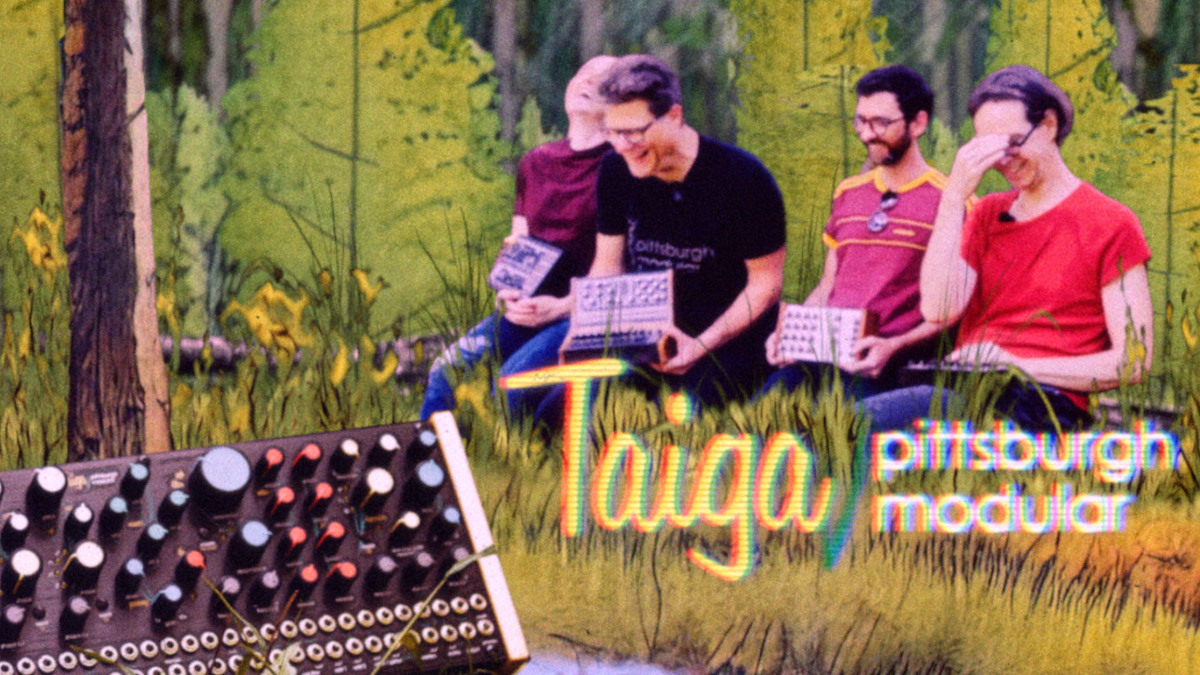
Taiga, though, feels to me like a surprisingly open-ended sonic playground. Despite the fact it seem to quite so strongly embrace esoteric synthesis tricks as does the Voltage Research Lab that preceded it, it has enough quirky and unique characteristics that I think hardcore modular enthusiasts and sound designers would do well to consider it. At the same time, it features a fairly straightforward, classic signal flow, making it a great choice for those already familiar with synthesis who are looking specifically to dive into the world of modular synthesis. Similarly, despite its conceptual depth, it could be a great starting point for complete newcomers as well: while not quite so straightforward as, say, the East Beast or West Pest, it should provide plenty of sonic territory for anyone to explore for years to come.
Pittsburgh's long history of self-contained instrument design and deep exploration of East Coast and West Coast synthesis principles has found a new embodiment in Taiga. Emerging from a time when Pittsburgh has been focused primarily on limited-run modules, we're excited to see them return to full-scale production with such a deep, well-thought-out instrument. We're truly excited to see how it will be used—and of course, we're excited to see where it leads Pittsburgh next. To Richard Nicol and Michael Johnsen—you've made a really spectacular and rich instrument.

